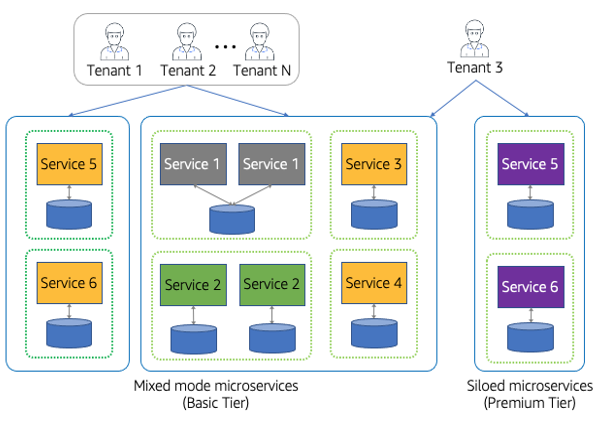The Mixed-Mode Deployment Model
To this point, I’ve focused heavily on the full stack models. While it’s tempting to view multi-tenant deployments through these more coarse-grained models, the reality is that many systems rely on a much more fine-grained approach to multi-tenancy, making silo and pool choices across the entire surface of their SaaS environment. This is where we look more at what I refer to as a mixed mode deployment model.
With mixed mode deployments, you’re not dealing with the heavy absolutes that come with full stack models. Instead, mixed mode allows us to look at the workloads within our SaaS environment and determine how each of the different services and resources within your solution should be deployed to meet the specific requirements of a given use case.
Let’s take a simple example. Imagine I have two services in my e-commerce solution. I have an order service that has challenging throughput requirements that are prone to noisy neighbor problems. This same service also stores data that is going to grow significantly and has strict compliance requirements that are hard to support in a pooled model. I also have a ratings service that is used to manage product ratings. It doesn’t really face any significant throughput challenges and can easily scale to handle the needs of tenants–even when a single single tenant might be putting a disproportionate load on the service. Its storage is also relatively small and contains data that isn’t part of the system’s compliance profile.
In this scenario, I can step back and consider these specific parameters to arrive at a deployment strategy that best serves the needs of these services. Here, I might choose to make both the compute and the storage of my order service siloed and the compute and storage of my rating service pooled. There might even be cases where the individual layers of a service could have separate silo/pool strategies. This is the basic point I was making when I was first introducing the notion of silo and pool at the outset of this chapter.
Equipped with this more granular approach to silo and pool strategies, you can now imagine how this might yield much more diverse deployment models. Consider a scenario where you might use this strategy in combination with a tiering model to define your multi-tenant deployment footprint.
The image in Figure 3-11 provides a conceptual view of how you might employ a mixed mode deployment model in your SaaS environment. I’ve shown a variety of different deployment experiences spanning the basic and premium tier tenants.

